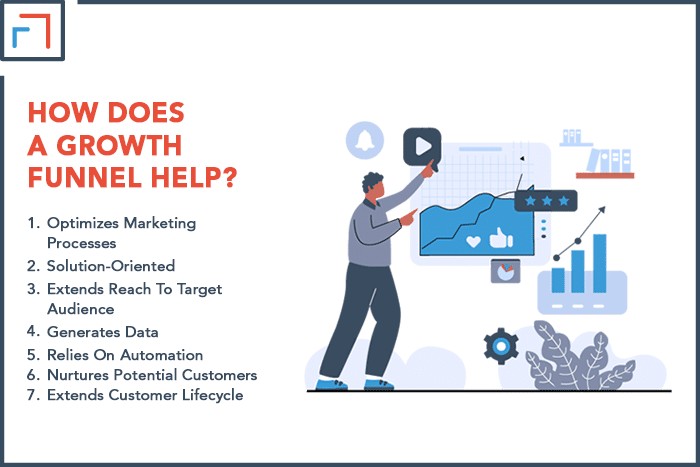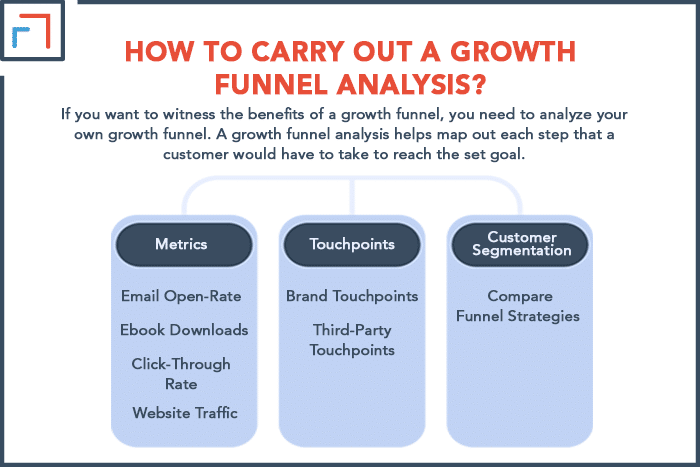There are many different types of funnels that people can use to grow their businesses. Growth funnels are a popular type, and it’s important to understand what they are and how to analyze them.
The growth funnel continuously improves itself to deliver effective marketing results. It helps you grow your business in every aspect, from awareness and nurturing to retention and relationship management. By looking at relevant data and key metrics, you can track the progress of a growth funnel.
If you use a growth funnel for your business, you need to use effective strategies. But if you’re not sure whether the growth funnel would work for you, this breakdown is what you need.
What Is A Growth Funnel?
A growth funnel is a type of marketing funnel that focuses on establishing a brand. It usually leaves the revenue aspect to the sales team. The goal is to build the brand and make it more familiar to the target audience.
Unlike most funnels that focus on conversions, a growth funnel creates and maintains customer relationships.
Since most modern marketing processes are digital, growth funnels can also be used as a type of digital marketing strategy.
As a result, these funnels can predict growth patterns by using relevant digital metrics.
Growth funnels optimize lead generation alongside the customer journey. This involves using targeted strategies to achieve business goals.
Startup companies and small businesses usually use growth funnels to establish themselves in the market.
This is because growth funnels essentially increase brand awareness. Even so, established brands also use growth funnels to expand and improve customer retention.
How Does A Growth Funnel Help?
1. Optimizes Marketing Processes
A growth funnel targets every aspect of a marketing process.
This is a full-funnel approach, which increases avenues for your target audience to come across your brand. It also focuses on customer engagement and retention.
As an entrepreneur, you can use growth funnels to constantly improve the different marketing steps.
These periodical changes are aligned with your predetermined business goals and objectives. Think of your business as a ship.
Every now and then, it may steer a bit off course. But the growth funnel acts as a compass to redirect your ship back to its original destination.
2. Solution-Oriented
Funnels can have leaks and ineffective strategies. But a growth funnel’s constant function is to find the weaknesses and solve marketing problems.
It uses a combination of relevant optimization strategies that are tailored to different customers and brand stages.
This type of problem-solving reduces expenses and informs businesses on how to adapt their brand strategy.
3. Extends Reach To Target Audience
Merely capturing a large audience isn’t the focus of a growth funnel. Instead, the funnel reaches individuals that belong to the brand’s target audience.
High-impact brand awareness is the key goal of a growth funnel.
This also includes choosing tools and strategies that work well for the company while removing the ineffective ones.
As a result, you save time and resources. You can even spot reliable growth patterns.
4. Generates Data
A growth funnel involves the constant testing and retesting of your marketing strategies.
You gain valuable data about your specific market, audience, and company every time. You can use this information to plan your next funnel changes.
Also, if you are planning a product release, you can time it efficiently according to your data about market and consumer trends.
5. Relies On Automation
A popular growth funnel strategy is email marketing.
Growth funnels use email automation to send personalized and trigger-based emails to the target audience.
This is another way that a growth funnel optimizes marketing through digital tools.
6. Nurtures Potential Customers
In addition to generating leads through brand awareness, a growth funnel also segments and nurtures these leads.
This is done by delivering targeted, valuable content.
Growth funnels use relevant blogs, webinars, and freebies to engage with consumers. Marketers can then develop strategies based on consumer behavior.
For instance, after analyzing engagement, your growth strategies may include adding demos and free trials.
7. Extends Customer Lifecycle
A growth funnel adapts your marketing processes based on the needs of your ideal customers.
This personalized marketing approach delivers a customized brand experience. As a result, customers are more likely to stay loyal to the brand.
By focusing on retention strategies, the growth funnel helps businesses to maintain customer engagement.
Instead of considering a purchase as the goal, growth funnels prioritize long-term customer relationships.

How To Carry Out A Growth Funnel Analysis?
If you want to witness the benefits of a growth funnel, you need to analyze your own growth funnel.
A growth funnel analysis helps map out each step that a customer would have to take to reach the set goal.
1. Metrics
First, determine the metrics that allow marketers to assess how well the different marketing stages function.
Here are some essential metrics to include in a funnel analysis:
Email Open-Rate
If your email open rate is lower than expected, the target audience is not interested in your suggested content.
This might mean that your email subject lines have to be more targeted to intrigue the reader.
Ebook Downloads
This metric demonstrates the engagement level of the potential consumers.
Like the previous metric, the number of e-book downloads is linked to your growth funnel’s content strategy.
Click-Through Rate
A CTR shows how relevant or persuasive your ads are when using a paid ads campaign.
Depending upon how low or high your CTR is, you will find out if your copy and keywords are effective.
Website Traffic
The number of visitors your website receives can be a good indicator of your overall brand impact.
Since a growth funnel prioritizes brand awareness, this metric would show the efficiency of the funnel steps that lead customers to the website.
2. Touchpoints
The key touchpoints for consumers also need to be distinguished. These are different places where customers may come across the brand or interact with it.
Identifying these touchpoints is important because it helps you evaluate how the growth funnel uses awareness and engagement opportunities.
Brand Touchpoints
On digital platforms, these touchpoints could include the company website, social media accounts, and online ads.
All these touchpoints would be owned and controlled by the brand; hence they’re easier to track.
Third-Party Touchpoints
On earned or shared media, your brand may be mentioned and referenced.
For instance, bloggers and influencers might try your products and recommend them to others.
User-generated content, reviews, and general word-of-mouth are common ways that customers are exposed to brands.
3. Customer Segmentation
This is the third key aspect of the growth funnel analysis.
By segmenting your audience, you can compare and evaluate how the same growth funnel strategies are working for different types of customers.
For instance, customers belonging to a younger age group may engage more than the older age group.
This step would identify how the growth funnel may need to tweak its strategies for specific subgroups of customers.

Points To Remember
A growth funnel will help you constantly revamp your marketing process by increasing efficiency.
This marketing funnel increases brand awareness and deepens customer relationships through personalized steps.
Use the data that your funnel produces to make informed marketing decisions.
Implement a funnel analysis strategy so your growth funnel can adapt in response to key metrics and touchpoints.
